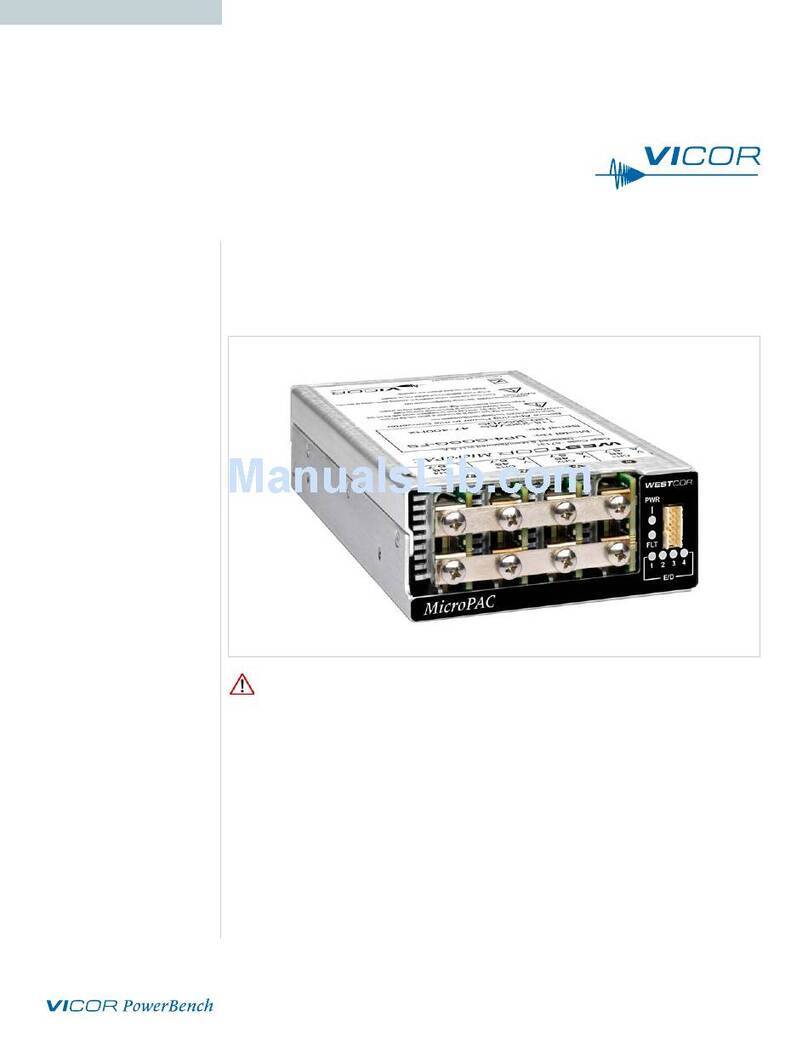
UG:121 Page 6
Sense Connections
Sense connections on output connections with studs:
The PFC Micro™ is shipped with Autosense installed
(For more information on Autosense, refer to page 14)
For remote sense, connect remote-sense wires to remote-sense/trim-pin access connector S1/S2 J2.
Connector pin S1/S2 J2-2 is the +SENSE and
S1/S2 J2-3 is the –SENSE.
Use Molex mating receptacle #50-57-9403 with #16-02-0103 terminals.
Attach terminals to 24 – 30AWG stranded twisted pair wire using Molex tool #11-01-0208.
Attach opposite end of sense lines to their respective outputs to point where regulation is desired.
Verify that sense lines are not cross-connected.
Sense connections on output connections with 18-pin Molex connectors:
The PFC Micro is shipped with Autosense installed
(For more information on Autosense, refer to page 14)
If remote sense is desired, connect remote sense wires to sense lines of Connector S1/S2 J1.
Connector pin S1/S2 J1-13 is the +SENSE and
S1/S2 J1-15 is the –SENSE for output #1.
S1/S2 J1-4 is the +SENSE and
S1/S2 J1-5 is the –SENSE for output #2.
Use Molex mating receptacle #39-01-2180 with #39-00-0039 terminals.
Attach 18 – 24AWG stranded twisted pair wire using Molex tool #11-01-0197.
Note: Remote sense is NOT available for triple-output slots.
Trim Connections
Trim connections on output with studs:
S1/S2 J2-1 provides trim access.
Use Molex mating receptacle #50-57-9403 with #16-02-0103 terminals.
Attach 18 – 24AWG stranded wire using Molex tool #11-01-0208.
Trim connections on connector with 18-pin molex connectors:
S1/S2 J1-6 provides trim access for output #1, and
S1/S2 J1-14 provides trim access for output #2.
Use Molex mating receptacle #39-01-2180 with #39-00-0039 terminals.
Attach 18 – 24AWG stranded wire using Molex tool #11-01-0197.
Trim connections on connectors with 16-pin Molex connectors:
S1/S2 J1-14 provides trim access for output #1, and
S1/S2 J1-6 provides trim access for output #2, and
S1/S2 J1-3 provides trim access for output #3.
Use Molex mating receptacle #39-01-2180 with #39-00-0039 terminals.
Attach 18 – 24AWG stranded wire using Molex tool #11-01-0197.
Interface Connections
CBJ3-1 is Signal Ground,
CBJ3-2 is Power Good Read and
CBJ3-3 is AC-OK.
CBJ3-4-9 are Enable/Disable,
CBJ3-10 is General Shut Down,
CBJ3-11 is Power Good Data Valid (PGDV) and
CBJ3-12 is +5 VS.
Use Molex mating receptacle #50-57-9412 with #16-02-0097 cinch pins.
Attach terminals to 24 – 30AWG stranded wire.
1
2
3
Sense Connections
Trim Pin
+REMOTE SENSE
–REMOTE SENSE
Pin
S1/S2 J2
1
2
3
Trim Connection with Batmod
Current Trim Access
Voltage Trim
Current Monitor
Pin
S1/S2 J2
9 8 7 6 5 4 3 2 1
18 17 16 15 14 13 12 11 10
S1/S2 J1
- + + T - + - - +
- - + - T + - + +
S1/S2 J1 (18 Pin)
9 8 7 6 5 4 3 2 1
18 17 16 15 14 13 12 11 10
S1/S2 J1
- + + T - + - - +
- - + - T + - + +
S1/S2 J1 (18 Pin)
8 7 6 5 4 3 2 1
16 15 14 13 12 11 10 9
S1/S2J1
- + T - + T - +
- + T - + N/C- +
S1/S2J1 (16 Pin)
CBJ3 E/D INTERFACE CONNECTOR
MATING CONNECTOR: (WESTCOR KIT P/N: 19-130044)
HOUSING: MOLEX (50-57-9412)
SOCKET CRIMP 24-30 AWG: MOLEX (16-02-0097)
CRIMP TOOL: MOLEX (11-01-0209)
PIN DESCRIPTION
CBJ3-1 SGND
CBJ3-2 PGR
CBJ3-3 ACOK
CBJ3-4 ED6
CBJ3-5 ED5
CBJ3-6 ED4
CBJ3-7 ED3
CB3-8 ED2
CBJ3-9 ED1
CBJ3-10 GSD
CBJ3-11 PGDV
CBJ3-12 +5 VS





























